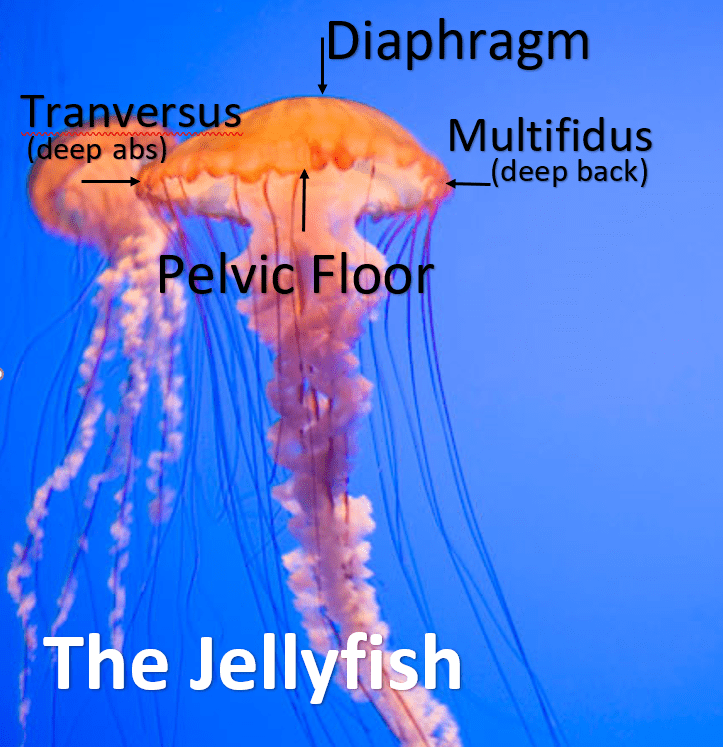The jellyfish is strange-looking creature that given half a chance will sting you in the sea and may require your best friend to pee on you! So how on earth does this relate to your fitness and health?
Well if you can visualise how a jellyfish swims you can imagine this is how the deep muscles of your body work together. As one lifts, so does the another, as one contracts the opposite relaxes. One up, one down and so on. This constant co-working of these muscles help to keep the pressure within the abdominal cavity the same. Basically this means that no excessive pressure is placed on other parts of the body – essential for pelvic floor health, abdominals (diastasis recti, hernia), breathing issues and back pain (could include disc herniation).
When there is excessive pressure placed on one or more of these areas it can cause pain and problems, both long and short-term. But how do you know if you are creating that excessive pressure (intra-abdominal pressure)? First up are you holding your breath whilst doing something? Think going from sitting to standing, lifting something or going to the toilet? In one word straining? That pressure has to go somewhere. Think of a bottle of water – if you squeeze the bottle that water gathers in one place more than others. There is only so much it will take before that bottle would burst – most likely the lid would pop off! Any excess pressure within your ‘core’ could essentially end up the same.
By using the jellyfish we can start to encourage that pressure to remain constant and in turn, protect our ‘cores’. So let’s revisit that jellyfish. Imagine the top of the jellyfish is your diaphragm, the bottom or underneath your pelvic floor, the front and sides are your deep tummy muscles (transversus) and deep back muscles (multifidus). As you breathe out the top of the Jellyfish will lift and so in turn will the bottom, the sides will draw in. The jellyfish gets smaller and longer. Your torso won’t but let imagine your waist shrinks a little. The opposite now happens, you breathe in and the top flattens (your diaphram does actually appear to ‘flatten’ as you inhale), the bottom also flattens and the back and sides become wider and fatter. Imagine your rib cage and all the way down to your pubic bone is filling with air and expanding out to the sides. This where you don’t want to push the air too much into the tummy like a balloon, but more imagine your ribs widening and expanding outwards.
Ok so that’s the basic jellyfish. This is hard on its own, so practice this a while first before applying to movement. Practice in all different positions; laying, sitting, standing, after all at some point you need to get off the floor and take the washing out of the machine. Once you’ve mastered(ish) the basic, apply it to movement. Let’s take the squat – the most functional exercise you can do. You do it every day in many forms without even thinking about it. You squat to stand and sit, get on and off the toilet, pick things up, get in and out of a car, the list is endless. So using your jellyfish, as you go down (least effort) breathe in and allow the muscles to lengthen. As you stand (most effort) breathe out and lift the pelvic floor and draw the tummy in – no squeezing! Easy as that! For those who have done birth preparation classes this is the opposite of what you are taught. And for a reason – you want to push a baby out!
This principle can then be applied to any movement, whether it’s an exercise or daily task. Breathe IN on the least amount of effort, breathe OUT on the EFFORT and lift and draw in the rest of the core muscles. It does take practice, but once mastered your back, abdominals, pelvic floor and even your upper back will thank you for it!


